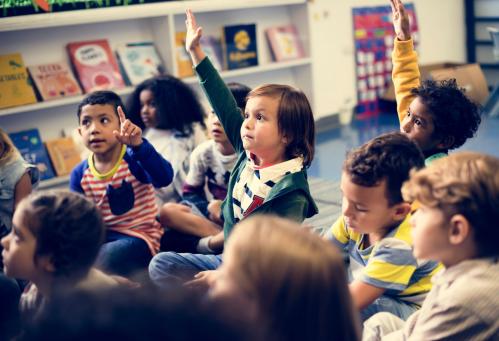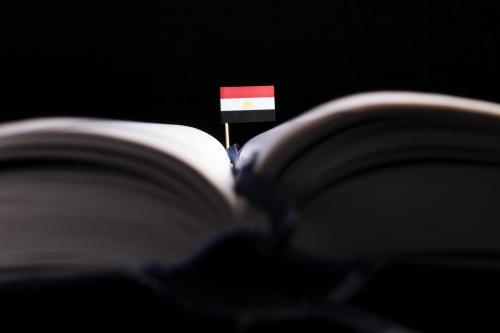This is the second in a series of blogs that look at the experiences of Syrian refugee children and their teachers.
Five years ago, the state of Lebanon’s public education system was rarely a topic of discussion. In fact, less than one-third of the country’s children enroll in public school (around 300,000 students a year). However, since the start of the Syrian conflict the demand for education in Lebanon’s government schools has increased significantly. An estimated 360,000 school-aged refugee children have fled into Lebanon from Syria and the Ministry of Education and Higher Education (MEHE) and the United Nations High Commissioner for Refugees share a goal of integrating them into public schools. To cope with the massive influx of young people, the MEHE has adopted the strategy of “second shifts” for refugee children. This year, 160 of Lebanon’s 1,350 public schools are operating both a morning shift—primarily, but not exclusively for Lebanese children—and an afternoon shift for Syrian refugee children.
Second shifts—also called double shift or multiple shift and even “hot seating,” depending on the context—have been widely used as a strategy to expand access to education when infrastructure is limited. As far back as 1989, questions about the quality of these approaches have been raised and explored, especially when the same teachers work both shifts. Unique to a refugee context is the designation of each shift for a different population. For Syrian refugees, the second shift system will play a central role in educating the next generation. Much of that responsibility falls directly on the shoulders of public school teachers who face salient challenges on a daily basis.
Lebanese teachers teach both shifts
Adnan is 24 years old and has a Masters degree in Science. He thought he would work in nutrition and food science, but he is now a teacher at Al Hassan, a government school in his home country of Lebanon. He entered the profession quite simply because he loves to teach. Adnan teaches in both the morning and afternoon shifts at Al Hassan, starting the day at 8:00am and ending at 6:45pm. Like Adnan, most second shift teachers in Lebanon are also first shift teachers. Adnan works on contract and gets paid for each period that he teaches. Working during the second shift, in theory, is a considerable boost to his salary. However, as of February 2016, Adnan had yet to be paid any of his second shift salary for this school year, which began in September 2015. In fact, second shift teachers were not compensated for last year’s work until January of this year. It is unclear to Adnan why the payments from the MEHE have been delayed.
Despite the delay in payment for the work, many Lebanese teachers continue to dedicate time and energy to the second shift students. This is the third year that Rida has chosen to teach both the morning and afternoon shifts at Fooshat Amal, also a government school. Rida has an undergraduate degree in elementary education and speaks freely of her love of teaching. “I dream about my students,” she told us. But she worries for the refugee children she teaches in the afternoon. Rida sees that difficulties at home are causing one student to stop doing his homework, another cries often in class due to the death of his father, and she is unsure how to help yet a different student who becomes extremely agitated each time he gets something wrong. Rida is a dedicated and caring teacher, but her refugee students bring challenges and demands that she has not had to face before. She is past the realm of exhaustion, a feeling she cannot keep to herself. “The thing that I hate the most, although you did not ask me,” she said, is that “I am always nervous, tired, and sick. I cannot tolerate anyone, and I start crying.”
Lebanese teachers are exhausted and lack the training needed to teach refugees
Teachers’ exhaustion is more acutely felt in the second shift, intended for refugees. As Adnan noted, the first shift is always better because both teachers and students are “fresh.” Second shift exhaustion is compounded with a lack of training to meet the specific needs of refugee students. Adnan explained, “We are not properly trained and we don’t have the materials to train [ourselves].”
While Rida received no training specific to working with refugees, Adnan did follow a four-day course offered by the British Council. He found the training helpful, but he felt it was too broadly focused and addressed only a few of the challenges he faces in the classroom. However, Adnan does believe he learned to be more flexible through this training. If the second shift students fail the test, he allows them to repeat it at home. Or he will give them the test again as an oral exam. He finds that when he asks the students the questions orally, they often know the answer even if they could not write it down. He also learned how to mix Arabic and English in the classroom, an approach he now uses in both shifts. He explained, “I’ve changed a lot. I was more aggressive. I’m now more patient with them. I joke.”
However, the training only helped Adnan resolve a few of the learning challenges he faces with his refugee students. Adnan seems almost resigned to how little he can accomplish during the second shift. In the afternoons “I teach very slowly,” he said, “…if a chapter for the first shift takes one hour, in the second shift it takes two.” Adnan is not alone in this experience. Aatifa, who also teaches at Al Hassan School, described how her lessons “must be very simple in the afternoons… I don’t teach them much.”
Refugee students can feel alienated in Lebanese schools
Teachers in Lebanese public schools are overwhelmed by the hours they work and the specific academic needs of their newly arrived students. While teachers like Adnan, Rida, and Aatifa began with a deep commitment, they no longer have the “time, energy, or interest” to get to know the hundreds of students they teach daily. In fact, they know very little about their refugee students. Aside from the fact that they are refugees, Adnan says he does not know how long they have been in Lebanon, what their previous schooling was, or even many of their names.
In addition to being unknown to their teachers, teachers observed that Syrian refugee children in second shifts struggle to make friends as “they are always fighting.” Adnan described how his Lebanese students look at refugees as if “they are not from the same level… [they see them] as lower.” Similarly, Aatifa finds that her Lebanese students disparage refugees outside of school, saying things such as “Oh Syrians, yuck. They are disgusting.” She also described conversations in which other teachers noted that Syrians “have a bad smell.” Such reactions are very troubling to Aatifa. “I want [the Syrian students] to see that we’re good,” said Aatifa, “that the Lebanese [people] are good.” And yet, Aatifa sadly describes how teachers at her own school say horrible things in class to the students. Syrian parents have come to the school to talk about these comments and how much they hurt their children. “They have feelings,” Aatifa said. “They are not rocks.”
Second shifts have greatly expanded access to education for Syrian refugees in Lebanon. In working toward access to a quality education, we must also address the challenges that come with this model, including teacher over-work, lack of training, and alienation of refugee students. Expanding training such as that offered by the British Council is one step. Teachers also expressed the need for more and clear guidance on i) modifying their curriculum for refugee students’ needs; ii) developing support plans for students who have experienced violence; iii) creating space in the short time of the school day to interact with their large numbers of students and get to know them; and iv) ensuring compensation for their time and work.
Teachers like Adnan, Rida, and Aatifa are desperately trying to adapt their teaching to the needs of their refugee students and to work for inclusion, but they are worn down and feel fully on their own. From her isolated classroom after her seventh lesson of the day, Aatifa spoke quietly: “I’m the only one who’s trying to make something different. And no one helps… Like I’m swimming in the ocean by myself.”
Editor’s note: The authors have used pseudonyms to replace the names of individual teachers and schools referenced in this blog in order to protect their privacy.


Commentary
Inside Syrian refugee schools: Making room for refugees in second shifts
February 17, 2016